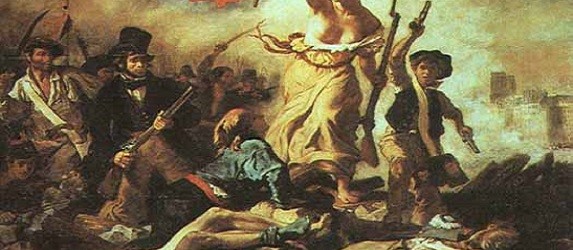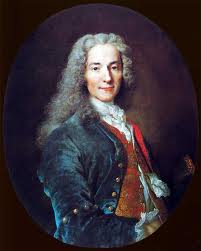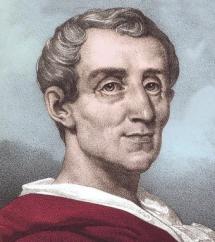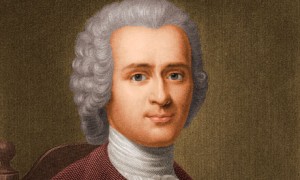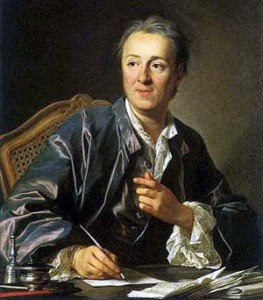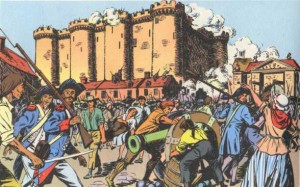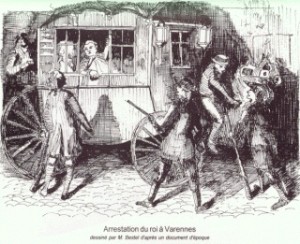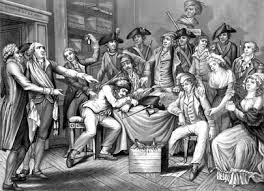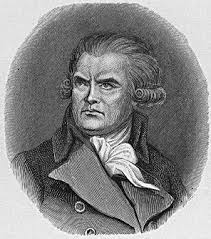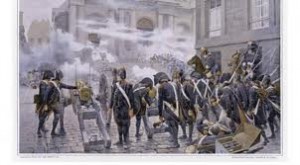The French Revolution of 1789 is one of the greatest events in human history which is often accepted as the pioneer of bourgeois revolutions. French Revolution not only changed political system in France, but also deeply affected men’s ideas and thinking patterns for many generations. Within in a short period of time (1789-1795), a completely new state was created by the revolutionaries by sweeping aside the remnants of the “ancien regime”. In every country around the world but primarily in Europe and America, the Revolution created hope and enthusiasm for new revolutionary movements. French Revolution is also very important since it brought the use of force and terror methods for political purposes on the agenda in the modern history. It’s better to analyze French Revolution by focusing first on the causes, then on the events and finally on the consequences.
I-) CAUSES
1. Class-based inequalities:
A-) The Peasantry: At the time of Revolution, the peasantry in France numbered about 23.000.000 in a total population of 25.000.000. However, in many parts of the country peasants were still having the conditions of serfs and being bought and sold with the land when it changed hands. Above all, there were the direct taxes collected by the state and called as the “taille”, which was a major source of problem and discontent for the peasants. There were also some indirect taxes such as the “gabelle” or the “salt tax” which were making life extremely difficult for the peasantry.
B-) The Bourgeoisie: Nearly all leaders of the French Revolution were coming from bourgeois background including merchants, traders, industrialists, lawyers, doctors and other professional groups. Although they had some exemptions from the taxation, they had no political power compared to the nobility at Versailles. This was the first and foremost reason for the bourgeoisie to support the Revolution. There was also no prospect of promotion for the bourgeois class in the French Army, where the commissioned ranks were the preserves of the nobility. Thus, the anti-elitist writings of Voltaire and Rousseau gained sympathy among the ranks of the bourgeoisie. In addition to this political problem, the bourgeoisie also had some economic problems. The finances of the government went from bad to worse during the reign of Louis XVI, especially in the times of American Independence War (1775-1783) due to French support given to American revolutionaries against the British forces. This meant more taxes from the peasantry and also from the bourgeoisie.
C-) The Nobility: A striking feature of French society before the Revolution was the absence of any real unity among the wealthy and privileged. The bourgeoisie envied and hated the nobility, which in its turn was seriously divided against itself. There were three different groups within the nobility; the Great Nobility, the Lesser Nobility and the Nobility of the Robe. The Great Nobility comprised about 1.000 “creme de la creme” families who owned the largest and wealthiest landed estates in France. They had been accorded privileges which placed them above all other classes in the state. The highest commands in the Army and Navy were reserved for them and they alone could represent France abroad as ambassadors. The most influential amongst them were the Court Nobles at Versailles who strongly resisted all attempts to end their exemptions from taxation and were determined to maintain their privileges. The Lesser Nobility comprised about 99.000 families and their situation was not comfortable as the Higher Nobility. They did not have chance to reach posts reserved for the Higher Nobility. Thus, it was not surprising to see that some members of the Lesser Nobility supported the Revolution. The third noble group was the only group that really deserved and acquired nobility by their merit, but again they were not enjoying the privileges of the Higher Nobility. In conclusion, nobility was divided in itself and was not able to resist to revolutionary movements.
D-) The Church: The Catholic Church was the established church of France and although various forms of the Protestant faith existed in France at that time, they were not officially recognized. The only public worship allowed was that of the Catholic Church and Church had the monopoly over education. Thus, the Church was under the harsh criticism of French intellectuals such as Voltaire. There were also inequalities within the clergy since the higher clergy was living in luxury whereas other parts of the clergy were not enjoying these conditions. It must be also added that the wealth of the Church was immense and on that account revolutionary classes’ look towards the Church was very critical and full of envy.
E-) The Army: Leading force for the despotic monarchy was coming from the Army. However, French Army at those years was far from being a reliable instrument of the monarchy. There were some secret societies within the Army due to the spread and influence of democratic and revolutionary ideas and ideals of French intellectuals. In addition, reserved posts for the Higher Nobility and the lack of meritocracy in the Army were causing anger of the young and bright soldiers. The effect of American Independence War was also visible in the Army.
F-) The Government: The government of France in 18th century rested in the King, the Royal Council and the Intendants. All power, in the last resort emanated from the King as it can be understood from Louis XIV’s famous saying “L’état c’est moi (State is me)”. The King was above the law, not controlled by it unlike British constitutional monarchy of the period. This was creating reactions within the French intellectual circles and enlightened bourgeois class. The regime was corrupt and the despotic government was becoming more and more inefficient. Any intelligent citizen in that period would not need philosophers to point out the corruption and injustice of the government. There was indeed, chaos and delay in every department of the state.
2. Influence of Great French Thinkers:
18th century was the peak for French intellectual progress where intellectuals like Voltaire, Rousseau and Montesquieu lived and wrote their chef d’oeuvres.
A-) Voltaire (1694-1778): Great French writer Voltaire did more than any other man in the 18th century to undermine the old regime and society in France. Voltaire was a man of letters and essentially a destroyer. His influence with the educated bourgeoisie was immense and he was even courted by kings and nobles – until he said too much for them. Voltaire reserved his most bitter attacks for the Catholic Church and Christianity in general, both of which he regarded as the essence of superstition and ignorance. Yet, when some of his atheist followers went to extremes in their attacks on all religion, he himself asserted the need of belief in some Supreme Being. Such a belief he regarded as a common-sense necessity, but most other aspects of religion by considered quite opposed to common sense. He particularly attacked religious intolerance and denounced the laws that allowed only public worship of Catholic kind. Voltaire, similar to his French contemporaries, was affected by British political philosophers including Thomas Hobbes and John Locke. In 1734, he published his famous work Letters on the English and praised British political system over the French. Voltaire loved high degree of religious toleration and freedom of press in Britain most. He was not a real republican but his views helped republicanism to develop.
Voltaire
B-) Montesquieu (1689-1755): The influence of Montesquieu was great in a more strictly political sense than that of Voltaire. Montesquieu’s main concern was to limit the powers of the Monarch, and anything, even privileges of the nobility, which hindered the absolute power of the King, was good. He was one of the earlier advocates of separation of powers. He found British political system more successful than French one because of check and balance mechanism within the system. He expressed his important views in his work The Spirit of Laws (1748).
Montesquieu
C-) Jean-Jacques Rousseau (1712-1778): The basic idea of Rousseau as he expressed in his most famous work Du Contrat Social (The Social Contract) was that the “general will” of the people should be the ruling force in any country. His theory of social contract was similar to British example of social contract theories, however unlike Hobbes and Locke, Rousseau praised and exalted the primitive man and offered going back to rural life as a solution to the problems of modern and corrupt society. Leading revolutionaries such as Robespierre were fanatical followers of Rousseau.
Jean-Jacques Rousseau
D-) The Encyclopedists: Among the great intellectual influences of the 18th century we must certainly look at the famous Encyclopédie. Two great names behind this were Diderot and D’Alembert. Their aim was to produce a work which would summarize all existing knowledge, and the finest thinkers of the age contributed to the implementation of the project. However, later its editors were imprisoned and the publication of Encyclopédie was banned. Its contributors included Voltaire, Montesquieu and Rousseau.
Diderot
E-) British Intellectuals: The role of British intellectuals on French Enlightenment was visible. Leading French philosophers of the epoch had previously seen British constitutional regime and enjoyed some democratic rights. So, they wanted France to have a similar regime.
3. Financial Crisis:
During the reign of Louis XVI, France was in extreme financial crisis and near bankruptcy due to Seven Years War’s burden on the economy, state’s limitless help to American revolutionaries in American Independence War as well as the inefficient tax system. Neither Finance Minister Turgot, nor Comptroller-General of Finance Jacques Necker could find a solution to this situation. Financial crisis decreased the number of regime’s supporters and encouraged and provoked revolutionaries.
4. Unpopular Ruler:
For some, it was possible to save the regime if a more adequate King than Louis XVI (1774-1793) would have been able to exercise decisive control over the course of events. Louis XVI inherited from his predecessors the position of a despot without having the character of a real despot. He was amiable and well-intentioned but such sentiments were not enough. He also lacked the will to persist with reforms and his Queen Marie Antoinette exercised a reactionary influence over him. Antoinette was the daughter of Maria Theresa, Empress of Austria. She was very unpopular in France since she represented the alliance of Austria and France. Her education was narrow and she was known as the outsider “L’Autrichienne” by French people.
5. Revolutionary Spirit:
Revolutionary spirit of the American Independence War was also influential in the emergence of French Revolution. During the war between England and her colonies, Louis XVI’s government had made an alliance with the colonists, and French forces under General Lafayette had served in America. After the war, French soldiers returned their home with democratic ideas and ideals. “No taxation without representation” was the slogan of American revolutionaries which also affected French revolutionaries.
II-) EVENTS
1. First Phase: Abolition of feudalism and the attempts to create a constitutional monarchy
Etats-Généraux or States General met at Versailles on 5 May 1789 and it was opened with a three-hour speech by Necker. It compromised of the representatives of the clergy (first estate), the nobility (second estate) and of bourgeoisie and peasantry (third estate). The method of electing the members of the States-General was that employed in the year 1614, when it had last met. Elections were held in the spring of 1789 and produced a parliament composed of 308 clergy, 285 nobles and 621 members of the third estate. The third estate in fact had double representation of each of the other estates but the government’s handling of the third estate at Versailles was clumsy from the first day. All the ancient ceremonials were rigidly maintained, which emphasized the first and second estates. Louis thought of dealing with three estates separately. This would mean two privileged orders being able to outvote the third estate by two votes against the one. If on the other hand, they sit as one in the assembly, the third estate would certainly outvote the other two. Thus, the third estate immediately put forward the demand for a single assembly voting by heads. Louis’s reply was to insist on the ancient procedure of voting by separate estates. The third estate members invited the clergy and nobles to discuss this matter with them. Several conferences were help between May 23 and June 9 but negotiations turned out to be unsuccessful. On June 12, the third estate declared itself as the National Assembly and invited the other estates to join them.
The self-conversion of the third estate into the National Assembly was the real beginning of the French Revolution. This decision ended six weeks of wrangling and time-wasting over the question of procedure. It meant a complete break with the old law of the constitution. The defiance of the King by the third estate created a tense situation, for the third estate had literally swept aside the assemblies of nobles and clergy. Louis was alarmed by the stubborn determination of the third estate and under pressure from his advisers of the Court, decided to hold a “Royal Session” of all three estates together at which he would give them his direct personal instructions. The Royal Session took place on June 23. Louis’s coach made a speech and promised a series of reforms. However, he made a grave mistake and ordered three estates to be separate and declared third estate’s move of naming itself the National Assembly as illegal. This was a turning point because members of the third estate did not leave their ranks. Count Mirabeau strode towards the Master of Ceremonies and exclaimed: “Go tell your masters we are here by the will of the people and that we shall not leave except at the point of the bayonet!”. Against this resistance, Louis did nothing and members of clergy and nobility also started to join the third estate. Finally, Louis accepted the situation and ordered the clergy and nobility to join the third estate. He was in a humiliating position.
However, Court nobles and members of the Royal Family were not prepared to accept the situation as resignedly as Louis himself. All their efforts were concentrated on the defeat of National Assembly by the use of force or by the threat of use of force. A large body of troops under Marshal de Broglie, mostly composed of the foreign regiments, was now concentrated at Paris and Versailles. The members of the National Assembly, fearing that some attempt was about to be made to suppress them, spread the alarm to their constituents throughout France. Demonstrations and riots started in many places. Especially bread-riots became widespread. There were now political forums and clubs everywhere. On June 30, a mob of Parisians attacked the Abbaye prison and released imprisoned soldiers. It was in these conditions that the forces of Marshal de Broglie arrived in Paris and Versailles. Almost at once events took a more violent turn. It was above all the dismissal of the popular Necker by the King on the demand of the Court party that was the signal for action.
The capture of the Bastille Prison (La Prise de Bastille) was a real turning point for French Revolution. On July 14, revolutionaries attacked on the Bastille Prison. Only seven prisoners -common criminals- were found inside the Bastille, but still it was a symbol for the downfall of the tyranny. Many political prisoners arrested under the odious system of “letter de cachet” had in the past been imprisoned there and it had such distinguished inmates such as Diderot and Voltaire. The capture of Bastille Prison was hailed both in France and elsewhere as the greatest and most significant event of the century. Everywhere, people started to elect new local councils in towns and in countryside. The old court of justice, both provincial and manorial, was swept away. Widespread attacks were made by the peasants on the mansions of the nobility. The electors’ committee at the Hôtel de Ville now established the National Guard, declared July 14 a national holiday and adopted the new tricolor of the red, white and blue in place of the old white royalist flag. The Assembly now asked Louis to order the withdrawal of the troops with had been sent by de Broglie to Versailles. Louis agreed to this demand and the troops were withdrawn.
La Prise de Bastille
During the session of the National Assembly on August 4, historical changes were made and the old order was destructed. Starting from this day and this session, the Assembly had taken the title Constituent Assembly and decided to declare a Declaration of the Rights of Man as an introduction to the new constitution. This decision was the result of the excitement of the times and a general feeling of the vast importance of the Revolution for the whole of mankind. Above all, the Declaration showed the influence upon the deputies of American ideas and of the teachings of Rousseau. It asserted the right of the people to rule and that men were by nature equal, that there should be freedom of speaking, writing and printing, that every citizen should have the right through his representatives to make laws and impose taxation, and that nobody was to be imprisoned except by forms of law decided by the people. It was when the Assembly came to the question of the King’s position in the new constitution that serious trouble began. Some of the nobility demanded that the King have the right to veto any laws, while others insisted that this should be only a six-year veto on the same law. Finally, on the matter coming to the vote, the Assembly decided by 673 votes to 325 that the six-year suspensive veto to be adopted.
This decision of the Assembly intensified discussions. Robespierre and the Jacobins in the Assembly had opposed the right of veto because it would give to the King powers which he would use in defense of the aristocracy. The Jacobins had already considerable influence in Paris. The agitation was roused to a new height of fury by the King’s refusal to accept the decrees of August 4 abolishing feudalism. He also refused to sign the Declaration of the Rights of Man. On the morning of October 5, a huge crowd of women forced their way into the Hôtel de Ville, seized arms and dragging cannon along with them, began a march on Versailles. Their declared aim was to convince the King to lower the price of bread and to ensure the punishment of the officers who had insulted the new tricolor French flag. Lafayette, the popular hero of the American Independence War had been elected Commandant of the National Guard. Lafayette succeeded in restoring order by persuading Louis and the Queen to appear on a balcony before the crowd. Lafayette himself announced the King’s acceptance of the declaration of the Rights of Man and his willingness to go to Paris. Louis made a promise of bread to the people. From this moment in October 1789, Paris was dominated by the Revolution and the royal family was like prisoners.
The Assembly was determinate the change the position of the Church. So, the law known as the “Civil Constitution of the Clergy” had the effect of making all ecclesiastics servants of the state. Bishops and priests were now to be elected by the same people who appointed civil servants. The salaries of the clergy were to paid by the government. The Pope of Rome was to have no power of altering elections or matters decreed by the state. The law reduced the salaries of the bishops considerably, but increased those of the parish priests. Finally, all priests were to take an oath of loyalty to the Civil Constitution of the clergy. Many bishops and clergymen supported these changes since they sincerely thought that these changes could bring true Christianity.
Louis XVI signed the law for the Civil Constitution much against his will. A devout Catholic, it was a humiliation to him to have to oppose the Pope and what he considered to be the best interest of religion. It was this situation which determined him to make an effort to escape from France. He placed his last hopes on being able to join the “émigré” forces over the frontier and especially his brother-in-law, the Emperor Leopold of Austria. This was a last desperate gamble for independence but it failed. Louis, Marie-Antoinette and their children were recognized at the little eastern frontier village of Varennes. The effects of the attempt of Louis XVI to escape from France were decisive for the future of the Revolution. He lost what personal regard the people still had for him. By attempting to fall back on foreign help, he had wounded the French people in their tenderest spot, their love of the motherland. A second result of Varennes was the emergence of an openly republican party which came more and more to dominate the course of the Revolution.
Flight of Varennes
The new government had to something about the poor economic performance of people. So, they decided to sell Church’s lands with a policy called “assignats”. The sale of “assignats” was a clever move on the revolutionaries because it guaranteed people’s attachment to the newly flourishing regime. The Assembly also completed the new constitution in September 1791. The new Assembly was to consist of 745 members. It was decided to adopt a system of indirect election. All men over twenty-five years of age paying state taxes equivalent to three days’ labor and controlled in the National Guard were to be styled “active citizens”. These “active citizens” were to vote for electors who in their turn elected the members of the Assembly. This was a moderate form of representative government and shows that in 1791 the Constituent Assembly was still prepared to accept a form of constitutional monarchy, even after the flight of Louis to Varennes.
At the end of the first phase of Revolution in September 1791, France had already radically changed. Feudalism had been swept away on August 4, 1789, the Intendants had gone and new local elected councils had been set up. A new constitution had been declared; monarchy had been retained but it was shorn of its despotic powers.
2. Second Phase: The rise of Jacobins and the “reign of terror”
The elections of the new Legislature Assembly resulted in the return of 136 Jacobins, 264 Feuillants and a Center group of about 350 deputies. The old National and Constituent Assembly, with the idealistic motive of preventing itself gaining a monopoly of power, had barred its members from being elected to the Legislative Assembly. Thus, the new Assembly was composed of men with energy and enthusiasm, but with little previous political experience.
The Jacobins: This group came eventually to dominate the Revolution and were members of the Jacobin Club. The original members of the club were some deputies of the National Assembly from Brittany, and they gained their name from the fact that they held their meetings in the old convent of the Jacobins in Paris. The public was admitted to the debates of the club, and it gradually became the rallying center of all those popular elements which brought pressure to bear on the Assembly from outside. At first its membership had been wide, and even Mirabeau had been one of its presidents. But as time went on, it became dominated by outright republicans, of whom the most prominent were Robespierre and Marat. The club had more than two thousand affiliated clubs in the towns, cities and villages of France and they acted as a concerted, disciplined force. They played a prominent part in the elections to the Legislative Assembly and carried on a violent campaign against all moderate elements and supporters of the constitutional monarchy.
The Jacobins
Another important Paris club of this period was that of the Cordeliers, of which Danton was the most prominent member. Its activities were confined to Paris and its members were more distinctly working class or “proletarian” than the members of the Jacobin Club. It was strongly republican.
The Feuillants: The Jacobins, despite their campaign, were outnumbered in the Legislative Assembly by the Feuillants, and the Center. The Feuillants were numerically strong, but lamentably weak in organization and unity compared with the Jacobins. They wished to preserve a constitutional monarchy, but wanted to improve the new constitution. There were serious divisions in their ranks as to the way in which the constitution should be changed. From the position the Feuillants occupied in the Assembly they are usually referred to as the right.
The Center: The Center group wished to be independent of both right and left. But in the prevailing temper of Paris, and under pressure from the Jacobins and their supporters in the galleries, the Center became confused, divided and brow-beaten. One of the first measures which the Jacobins secured in the Legislative Assembly was the “appel nominal” by which each deputy had to declare aloud his vote on any question. This procedure resulted in the gallery being able to bring the weight of insult and terror to bear on individuals.
Another important event in the second phase of the Revolution was the war situation between revolutionaries and the émigré forces and Austria. Despite Louis disapproved the violent threats coming from émigrés to the Revolution, the threats continued and an army of 20.000 men was concentrated on the frontier of France in the territory of the German Elector of Trier. Then in August 1791, the émigrés persuaded the King of Prussia and the Emperor of Austria to issue the Declaration of Pillnitz. The two rulers asserted that the cause of Louis XVI was the cause of every monarch of Europe. The main result of this declaration was to strengthen republicanism in France and unite with it the forces of patriotism, a consequence which its authors had certainly not foreseen. Another serious development was the outbreak of a civil war in western France, in the region of La Vendée.
A section of the Jacobins under Brissot now demanded that Louis should order the Elector of Trier to disband the “émigré” army. They knew very well that this would lead to war, which they wished to bring about in order to overthrow the King. This section of the Jacobins were known as the “Girondins”, taking their name from the Gironde district of south-western France from which a number of them came. If they could bring about war, then Louis, having vetoed the decrees against the “émigrés”, could easily be shown as unfitted to lead the nation. The war policy was demanded by the principal leaders of the Girondins, including Vergniaud, Madame Roland and Brissot. From this point, a rift appears between the Girondins and the remainder of the Jacobins, for Robespierre, Marat, Danton and those supporting them were opposed to a war policy on the grounds that it led, not to a democracy of the people, but to dictatorship in which the wealthiest classes would be supreme.
The Girondins were, however, aided in their policy by support from an unexpected quarter. The Feuillants had secured the appointment of one of their member, Narbonne, as Minister of War, and they demanded a war policy from exactly opposite motives to the Girondins. They considered that a successful war would restore the popularity and power of the King. Thus, from entirely opposite motives, two main groups of the Assembly looked to war in order to gain their ends. Lafayette, also, was a party to this plan, but both Louis and the Queen opposed it, mainly out of distrust of Lafayette, whom they now regarded as the part-author of all their misfortunes through his failure to use the National Guard on their behalf. Louis dismissed Narbonne, and the Girondins succeeded in securing the appointment of one of their members, Dumouriez, as Minister of War. War was thus made certain, for a large majority of the Legislative Assembly was now in favor of it. It was regarded as the means of spreading abroad the spirit of the Revolution against kings and to the lasting benefit of peoples. “Peace to the peoples, war against the tyrants” became the ideal held before the French soldier. An ultimatum was sent to the Emperor of Austria demanding that he cease to support the “émigrés”. His reply was to make some unacceptable demands against the Revolution. The result was the declaration of war against Austria on April 20, 1792.
The declaration of war was a momentous change in the course of events. France was to be involved in war for more than twenty years, but the immediate results in France itself were to sharpen the conflict with the King and hasten the country towards a republican form of government. The French armies first moved against the Austrians in Belgium, and at once suffered severe defeats. Louis immediately dismissed the Girondist ministry and installed another composed mainly of the followers of Lafayette. He also vetoed further decrees against the non-juring priests and for the formation of an army to protect Paris. These actions by Louis led to the organization of a popular demonstration against the King on June 20, 1792. It was under Jacobin leadership that the crowd of demonstrators assembled in the Tuileries gardens and eventually broke into the Palace. Louis himself was surrounded for some hours by a group of demonstrators and was forced to don the red cap of the Revolution and to drink to the health of the nation. There were loud demands that he should withdraw his vetoes on the subjects of the “émigrés” and the non-juring priests, but Louis remained firm. Marie Antoinette had been similarly insulted. Some of his opponents probably hoped that Louis would be assassinated, but eventually the crowd was persuaded by some of the deputies from the Legislative Assembly to withdraw.
An effort was now made by the opponents of the Jacobins to suppress them, and the lead was taken in this by Lafayette. The humiliations suffered by the King on June 20 had led to a strong reaction in his favor among large sections of the public, and Lafayette determined to take advantage of this situation to restore the credit of the monarchy and put an end to the Jacobins. Louis himself had been greeted in the Assembly by cries of “Vive Le Roi!”. Lafayette had been given the command of the army on the eastern frontier, and he now left it in order to appear before the Assembly. The Jacobin organization now showed itself at its most effective. As soon as Lafayette appeared, he was accused of having deserted the army in the moment of France’s greatest peril, and they were able to sway the Assembly against him, while of course, their gallery supporters took up the hue and cry. Marie Antoinette herself, harboring an intense dislike of Lafayette, had actually warned the Jacobins herself that he intended to make a direct appeal to the National Guard! Lafayette’s plan was entirely foiled by the Jacobins and Marie Antoinette – a tragically ironic combination! Lafayette returned to the army, soon afterwards fled over the frontier and was imprisoned by the Austrians till 1797.
It was now that a new figure began his rise to power in Paris – Danton. Besides being the guiding spirit of the Cordeliers Club, he had also gained important office in the citizens’ council of Paris at the Hôtel de Ville. He now took a leading part in organizing a new insurrection, for which purpose the Jacobins had set up a special committee known as the Directory of Insurrection. He supervised the military organization of the Paris sections which were under Jacobin control, the guards at the Tuileries were changed, and the National Guard itself was reorganized in order to remove any possibility of its supporting the King.
Danton
It was Danton who gave the signal for insurrection. The forces of the sections and the “fédérés” were summoned by the tocsin bell of the Cordeliers Club in the early morning of August 10. At Hôtel de Ville a committee of Danton’s supporters drawn from the city sections suddenly seized power, suspended the old council and established the revolutionary Commune. Thus, the real power in Paris passed into the hands of Danton and the revolutionary Commune. The Assembly was reduced to a position of subservience and it was at this point that Lafayette on the frontier decided to leave the sinking ship of the monarchy. The Commune now forced the Assembly to suspend the King, and to make arrangements for the calling of a Convention to alter the constitution. The elections to the Convention were to be by universal manhood suffrage and not on property qualification.
It was immediately after the successful insurrection of August 10 that Maximilien Robespierre (1758-1794) became a member of the Paris Commune. From the time of his election to the States-General in 1789, he had been a member of the Jacobin Club. A fanatical follower of the ideas of Rousseau, he preached virtue and incorruptibility. A provincial lawyer by profession, he had also dabbled in literature and assumed an air of superiority and cultured refinement which came in time to exercise a fascination over his audience. Yet Robespierre, who was to bear much responsibility for both the September Massacres and the “reign of terror”, had abandoned his lawyer’s practice rather than to be a party to the passing of a death-sentence in the courts! Of his complete incorruptibility in all money matters and his unselfish devotion to the Revolution there is not doubt however.
Robespierre
The closest ally Robespierre at this time was Marat, a member of the Cordeliers Club and editor of the revolutionary paper L’Ami du Peuple. This paper was renowned for the sharpness and scurrility of its attacks on the aristocracy, the Church and the monarchy. Marat was one of the decisive, controlling influences behind the actions of the Paris mob at critical points of the Revolution, and was the main instigator of the September Massacre. Robespierre and his supporters in the Commune now began a furious campaign against all those, and especially the Girondins, who had in any way given support to the monarchy. The Commune established a censorship of the press and also removed from the voters’ list large numbers of people considered unfit to vote. The barriers of the city of Paris were closed, and an examination of letters entering and leaving the capital began. Robespierre demanded from the Assembly the custody of the Royal Family, who were now taken to the Temple prison. The Commune also gained the right to take action against all those who were suspected of acting against the security of the state. Thus, the Commune became the decisive ruling force in Paris and the advance of the Austrians and Prussians towards the capital made the measures taken increasingly severe. A ruthless discipline was enforced.
Further measures were now planned against all those suspected of royalist sympathies. The police activities of the Commune had filled the prisons of Paris to overflowing and plans were now made by Marat to dispose of the inmates. On September 2, orders were issued to bands of assassins, who went from prison to prison, dragged the inmates before hastily-formed tribunals and massacred them. About 1.200 people in Paris were killed in a few days. The policy of terror was also extended to provinces. The September Massacres were mainly prepared by Marat, supported by Robespierre and at least connived at by Danton, who was at this time Minister of Justice.
The first months of the new Assembly, the Convention, were marked by increasing conflict between the Jacobins and the Girondins. In the first place the Girondins were deputies of the provinces and were not prepared to accept the supremacy of Paris. The Jacobins, however, relied for their strength on Paris. Secondly, there was intense personal enmity between the leaders of the Girondins, such as Madame Roland and Vergniaud, and the Jacobin leaders, Marat, Robespierre and Danton. Thirdly, there was a marked difference between the two parties in their attitude to the King.
The most important event in this second phase was naturally the trial and the execution of King Louis XVI. The King was first brought to trial on a charge of having conspired against the nation by supporting the “émigrés” and the foreign sovereigns who were then attacking France. His vetoes had made the case against him a very strong one, and the Jacobins were especially determined to secure his conviction. By a majority of 53, the Convention voted for death, and Louis was guillotined on Sunday, January 21, 1793. He had become a tragic figure incapable of controlling the course of events. He was honest within narrow limits, he was sincerely religious, but was hampered by self-seeking advisers and a bigoted Queen, and above all, he was too weak for the exercise of despotism.
In terms of war, French armies started to recover after the first defeats. However, in February 1793, England entered the war against France. The policy of British Prime Minister William Pitt, the Younger, had been very cautious up to 1793. He had no wish to entangle England in a war against France, but became alarmed when the Revolution began to spread beyond the frontiers of France. Spain, Holland, the German and Italian states also entered the war against France. The execution of Louis had undoubtedly filled the rulers of Europe with horror and alarm and they now hoped that a concerted attack would destroy the new Republic. Besides this, they all had territorial aims against France. The result was the defeat of French forces and the beginning of another retreat in the Netherlands.
The Convention now decided on the creation of a new system to meet the serious situation which had again developed. It set up three important organs of government which came to control the life of Paris and the country – the Committee of Public Safety, the Committee of General Security and the Revolutionary Tribunal. At first the Committee was given control of the army and foreign affairs, but soon came to be the guiding force of the Revolution, controlling the Convention which had created it. It consisted of twelve members whose duties extended to every department of the state. Under its direction the Committee of General Security took charge of the actual police arrangements in Paris and the provinces. The Revolutionary Tribunal was a specially created court for the trial of those ordered before it by the Committee of Public Safety, and no appeal was possible from its verdicts. From day to day it fed the guillotine with victims.
The Committee of Public Safety and the Convention now raised 700.000 fresh troops in a few weeks and sent unsuccessful generals to the guillotine to show their insistence for the success in war. During the late months of 1793, a new French Army emerged, powerful, well-disciplined and successful. This was the result of the combination of terror and Herculean effort which marked the work of the Committee of Public Safety, mainly directed by Danton. On August 23, 1793, the famous “levée-en-masse” was decreed by the Convention. Under this decree, the whole population of France was brought into “permanent requisition” for the defense of the country and the prosecution of the war against the enemy. Unmarried citizens or widowers between the ages of 18 to 25 were the first to be called for military service, while married men, women and children were all assigned tasks directly related to the war effort.
The terror extended all over the France. In these months, many thousands were guillotined in Paris and the provinces. There were now two real bodies directing the Revolution; the Commune and the Committee of Public Safety. In the Commune, the control was in the hands of a group who wished to carry the terror to even more ruthless extremes. They also attempted to destroy whole Christianity in France. Under the influence of their leader, Hébert, they forced the Convention to introduce a new non-Christian calendar etc. This was followed by a campaign against Christianity itself and on November 10, the Cathedral of Notre Dame became a Temple of Reason. In short time, many churches in France turned into Temples of Reason. Robespierre opposed to this policy for two reasons; first he had the view that some kind of belief in a Supreme Being is necessary and the second he wanted to destroy the power of the Commune which could threaten the power of the Committee of Public Safety. The Convention finally ordered the arrest of Héberists. They were executed in March 1794.
3. Third Phase: The Fall of Robespierre and the creation of Directory Government
Having defeated the Héberists, Robespierre now turned against Danton. He opposed to Danton because of his views to end the policy of terror. Shortly afterwards, Danton was tried before the Revolutionary Tribunal which he himself helped to establish, was found guilty and guillotined on April 5, 1794. Robespierre had gained supreme power in both the Commune and the Committee of Public Safety. At the same time, he intensified the terror. The Revolutionary Tribunal’s procedure was made even more severe. This policy led to a sudden hardening of opposition to Robespierre. The Convention finally ordered his arrest on July 28 he was guillotined. Robespierre carried the revolutionary virtue but his stubbornness on terror and virtue caused the emergence of enemies towards him.
After the death of Robespierre, the policy of terror was abandoned. The Commune and other institutions created by the Jacobins were abolished. The Jacobins made attempts to regain control, but after a period of confusion, the Convention succeeded in closing down the Jacobin Club itself. The Convention now produced another constitution for France. It determined to uphold a republican form of government, but one which was less under the influence of the populace of Paris. To promote this object, the idea of universal suffrage was abandoned and the vote in elections was confined to tax-payers. France was to be governed by two bodies; the Council of Elders consisting of 250 members over 45 years of age and the Council of 500 consisting of 500 members over 30 years of age. Council of 500 could alone propose laws, but it was necessary for these proposals to be accepted by the Council of Elders. The actual day to day government was to be carried on by a Directory of 5 persons, one retiring each year, his successor being appointed by the Legislature. This system was an attempt to apply the lessons of recent experience, to have a check upon the power of the Council of 500 and by the system of yearly retirement, to prevent the possibility of a dictatorship being established by the Directory. The restriction of the vote to tax-payers was to insure against mob rule and to place elective power squarely in the hands of those possessing property.
However, the Convention was distrustful of certain groups in Paris and elsewhere who favored a restoration of the monarchy. The defeat of Robespierre and the relaxation of the censorship and terror had encouraged these groups of royalists to come into the open. To avoid the possibility of the royalists gaining substantial support in the elections, the Convention declared that two-thirds of the Council of Elders and Council of 500 should be chosen from members of the Convention itself. In opposition to this, the royalists and Jacobins organized an insurrection against the Convention on October 5. However, an order to fire upon the demonstrators was given and the crowd was dispersed. The episode became famous as “the Whiff of Grapeshot”, and the man who had given the order to fire was a young artillery officer, Napoleon Bonaparte.
The Whiff of Grapeshot
The next most serious internal opposition which the Directory had to face was that organized by François Babeuf. He was the leading member of one of the numerous societies to which the Revolution had given rise, the “Society of Equals”. Babeuf’s doctrines were the first organized expression of socialist or communist thought in these years. He aimed at the abolition of private property and the nationalization of all land. Naturally, his ideas took reactions from merchant-bourgeois classes but he had considerable support from poorest classes of Paris. Babeuf and his supporters attempted to seize the power but the conspiracy was betrayed and Babeuf went to guillotine.
Babeuf
In the two years, 1793-1795, victory had gone everywhere to French armies. The heroic work of Carnot, “the organizer of victory”, had turned the scales against the invading armies. Carnot had raised great armies, newly equipped and trained. The efforts of the French people in war after the Revolution had been prodigious. Another factor that helped French victory was the disunity among the allies of the First Coalition. Austria and Prussia were more concerned with their own territorial aims than with the restoration of monarchy in France. When the Directory was formed in 1795, Prussia, Spain and Holland had all been forced to make peace with France, but Austria, the German states, England and the north Italian state of Piedmont still remained in the war against her. The Directory decided to launch its main campaign against the Austrian Empire and to force the Austrians to accept the French conquest of the Austrian Netherlands (Belgium). Two great thrusts were planned by Carnot, one north of the Alps into southern Germany and the other into northern Italy. After that, England would be dealt with. The command of the armies of Germany was given to Generals Jourdan and Moreau, that of Italy to General Bonaparte.
III-) CONSEQUENCES
The French Revolution has received enormous amounts of historical attention, both from the general public and from scholars and academics and is still a subject of debate between different ideologies. There is no doubt that there are very few historical events that have become influential for many decades and centuries to come like the French Revolution of 1789. The views of historians, have been generally characterized as falling along ideological lines, with disagreement over the significance and the major developments of the Revolution. Alexis de Tocqueville for instance, argued that the Revolution was a manifestation of a more prosperous middle class becoming conscious of its social importance. Other thinkers such as the conservative Edmund Burke, maintained that the Revolution was the product of a few conspiratorial individuals who brainwashed the masses into subverting the old order – a claim rooted in the belief that the revolutionaries had no legitimate complaints. Other historians, influenced by Marxist thinking, have emphasized the importance of the peasants and the urban workers in presenting the Revolution as a gigantic class struggle. In general, scholarship on the French Revolution initially studied the political ideas and developments of the era, but it has gradually shifted towards social history that analyzes the impact of the Revolution on individual lives.
Finally, if we want to make a list of the consequences of the French Revolution, we can talk about these points.
– Feudalism was abolished in France starting from August 4, 1789. Anti-feudal ideas became widespread throughout the Europe. With the complete collapse of the existing regime, all elements of feudalism were abolished including serfdom.
– Nobles, clergy, towns, provinces, companies and cities lost all their special privileges in the new republican system.
– The Assembly published the Declaration of the Rights of Man and of the Citizen (August 26, 1789) which stated that the individual and collective rights of the nobility, clergy, and commoners were equal. These ideals in addition to slogans of the Revolution; liberty, equality, brotherhood became widespread in Europe and turned into ideals of many intellectuals and people.
– The Revolution is credited with having helped in spreading the ideas of democracy and nationalism across the world. The French Revolution was the death knoll for the rule of the monarchy, paving the way for democracy and nation-states.
– French Revolution brought about a lot of economic and social reforms, not only in France, but across Europe.
– In the years to come the world and particularly France was to realize the far reaching consequences that this bloody revolution had. The middle men known as the bourgeois and the land owning class were now in the most dominant social class in France.
– The idea of secularism or laicité became very stronger after the Revolution. Secularism and rationalism became a strong thinking pattern for intellectuals.
– The French Revolution brought a new and radical model of change (social revolution) different from British model of reform.
Dr. Ozan ÖRMECİ
REFERENCES
Summarized from;
– Peacock, H. L., (1982), “A History of Modern Europe 1789-1981”, London: Heinemann Educational.
– “French Revolution”, Wikipedia, Date of Accession: 03.07.2013, From http://en.wikipedia.org/wiki/French_Revolution.


